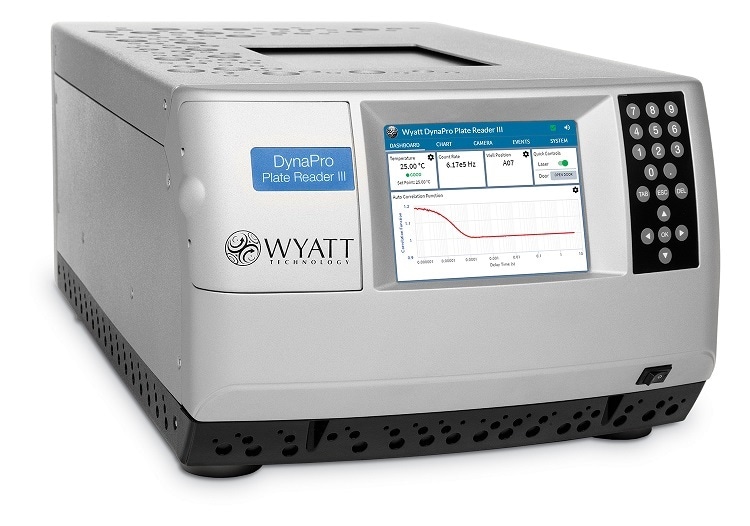In this interview, John Champagne, Senior Applications Scientist and Northeast Regional Manager from Wyatt Technology talks to New-Medical about the new DynaPro Plate Reader III and the impact it will have on screening proteins, nanoparticles and much more.
Why is it important to screen for developability and formulation of biologics?
It is vitally important to screen biologics for developability and formulation due to the limited time and resources available to modern biopharmaceutical companies. They require an optimized formulation, resulting in an optimally performing biologic, in as little time and with the lowest expense possible.
Also, biologics now face increasingly diverse storage and handling conditions. Being shipped around the block or around the world, these therapies must arrive intact and perform as intended. Without first screening for the most stable and efficacious biologic that is also formulated in the most stable buffer system, the success of the entire molecule is at risk, with concomitant impact on patients.
DynaPro Plate Reader III – Automated Biopharmaceutical and Nanoparticle Characterization
Tell us about the new improvements to the DynaPro Plate Reader III? What impact will they have?
There are several new features to the latest DLS plate reader instrument.
- Measures size, molecular weight, kD and A2 automatically and simultaneously, using industry standard microplates for the first time ever, to assess aggregation and stability by orthogonal methods.
- Improved ease-of-use with new Graphical User Interface wizards in the DYNAMICS control, data acquisition and analysis software
- Implements evaporation control during temperature ramps using sealing tape… Oil capping not required for kinetic or thermal experiments!
These innovations mark an entirely new level of productivity for scientists. The DynaPro Plate Reader III is the only instrument to combine both Dynamic Light Scattering (DLS) and Static Light Scattering (SLS) in a single, fully automated platform with measurements taken directly in 96, 384 or 1536 industry-standard microwell plates.
The new model of DLS plate reader can rapidly screen proteins, nanoparticles, colloids, and macromolecules to determine their size, molecular weight, aggregation and stability profiles using as little as 4 μL of sample. Furthermore, the instrument can characterize both conformational and colloidal stability indicators like Tonset, Tagg, A2 and kD by simply running a temperature ramp or concentration series.
Scientists can also acquire microwell images with the unique camera system to detect precipitation and debris, or quickly perform viscosity determinations to test the viability of highly concentrated biopharmaceuticals.

The DynaPro Plate Reader III from Wyatt Technology
What part does the DynaPro Plate Reader III play in high-throughput screening of biologic formulation?
For biotherapeutic formulation and development, the new DynaPro Plate Reader III is a comprehensive solution for stability evaluation. The instrument can measure aggregation, aggregate size distributions, changes in solution molecular weight, and propensity for aggregation: indicators of both thermal stability (Tonset, Tm, Tagg) and colloidal stability (A2/B22, kD) may be quantified with plate-based DLS and SLS. Even viscosity of concentrated protein solutions can be screened across dozens of formulations in a single plate.
While this instrument can serve as an all-in-one for initial screening of biologic developability and formulations, it can also integrate with other technologies in a plate-based workflow.

With the DynaPro Plate Reader III you can optimize workflow for all plate reader experiments? What does this mean for the user?
In-plate analysis saves you time and money! One can measure directly in 96, 384 or 1536 well plates, simply load and walk away. Also, microwell plates are disposable and less expensive per sample than disposable cuvettes. Integrate with plate and liquid-handling robots for even more time savings!
The same plates can serve in multimode plate readers, capillary-array loading, and sampling to UHPLC or other plate-sampled instruments. For example, an accelerated temperature stress can be applied to sample in plates in the DynaPro, with real-time DLS/SLS measurements and periodic UV/Vis measurements plus sampling to instruments that perform sub-visible particle detection or quantify remaining IgG monomer
How does the Plate Reader III compare to others on the market? What sets it apart?
In a word (or 2): high-throughput. The DynaPro Plate Reader III is the only instrument on the market that can measure DLS and SLS directly in an industry standard microwell plate. If you do not want to worry about sample manipulation or cross-contamination with other DLS systems on the market that claim to be plate based, all while optimizing productivity and performance, then the new Wyatt DLS plate reader is the clear choice.
Likewise, if you do not want to deal with the hassle and expense of capillary-array-based products that of necessity provide lower-quality DLS/SLS data.

Image Credit: Shutterstock/Kateryna Kon
What does the Plate Reader III mean for the future of biophysical screening?
It now means that a single researcher can examine content-rich screening data and tackle comprehensive DLS experiments you never thought possible.
Where can our readers go to find out more?
To learn more about the benefits of the DynaPro Plate Reader III and DYNAMICS’ all-new user interface please visit our website wyatt.com or contact us today by phone (805)-681-9009 or email ([email protected]).
About John Champagne
John Champagne, Ph.D. Senior Applications Scientist and Northeast Regional Manager for Wyatt Technology, graduated from the Physical Biochemistry Department at the University of New Hampshire, under the advisory of Professor Thomas Laue.
JC.jpg) Since joining Wyatt, John has provided a range of analytical support with expertise in the use of multi-angle static and dynamic light scattering, field flow fractionation, analytical ultracentrifugation, circular dichroism spectroscopy, UV-Vis spectroscopy, fluorescence spectroscopy and calorimetry.
Since joining Wyatt, John has provided a range of analytical support with expertise in the use of multi-angle static and dynamic light scattering, field flow fractionation, analytical ultracentrifugation, circular dichroism spectroscopy, UV-Vis spectroscopy, fluorescence spectroscopy and calorimetry.